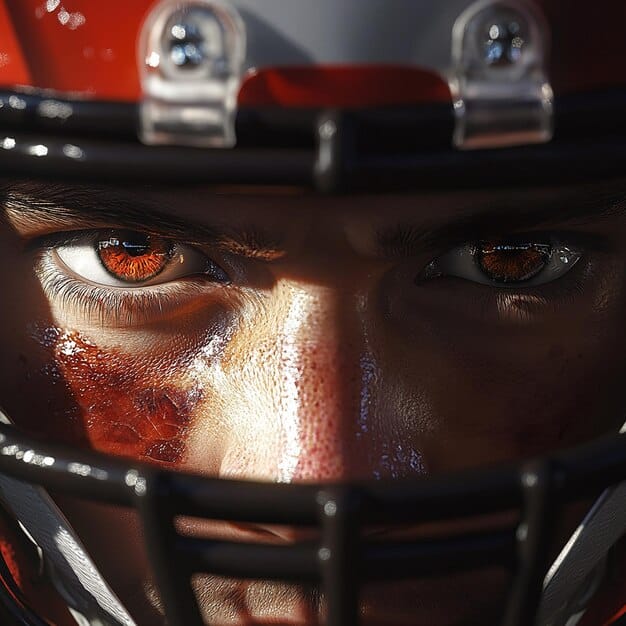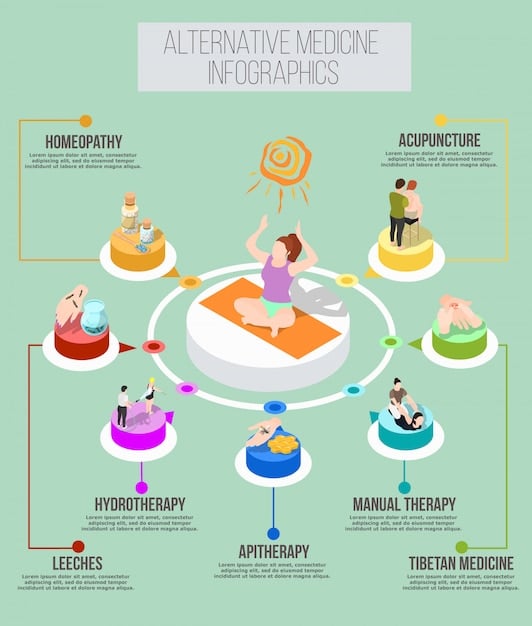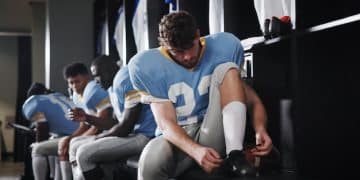NFL Concussion Protocol Changes 2025: Player Impact

The NFL’s updated concussion protocol for the 2025 season introduces significant modifications aimed at enhancing player safety through stricter enforcement, improved diagnostic tools, and changes to return-to-play guidelines, profoundly impacting how concussions are managed across the league.
The National Football League, a bastion of athletic prowess and intense competition, has long grappled with the inherent risks of its contact-heavy nature, particularly concerning head injuries. As the 2025 season approaches, the NFL is once again at the forefront of player safety, announcing significant modifications to its concussion protocol. These changes, more than just procedural tweaks, represent a critical evolution in how the league addresses traumatic brain injuries. Understanding what these new NFL Concussion Protocol Changes for the 2025 Season mean for players, coaches, and the sport itself is paramount.
Understanding the Landscape of Concussions in the NFL
Concussions have cast a long shadow over the NFL for decades, evolving from a dismissed “ding” to a recognized public health crisis. The league’s journey in addressing this issue has been characterized by scientific advancements, increased public awareness, and often, critical scrutiny. Early approaches to head injury management were rudimentary, lacking standardized protocols and relying heavily on subjective assessments.
However, as research illuminated the long-term neurological consequences of repetitive head trauma, including Chronic Traumatic Encephalopathy (CTE), the NFL was compelled to act. This shift led to the establishment of formalized concussion protocols, independent medical spotters, and significant investments in research and technology designed to mitigate impact forces. The transition from a reactive stance to a proactive one reflects a deeper understanding of brain injury mechanics and a growing commitment to player welfare.
Evolution of Concussion Protocols
The NFL’s concussion protocols have undergone continuous refinement, driven by new scientific evidence and a collaborative effort with medical experts. Each iteration has aimed to close loopholes, improve identification, and ensure greater accountability. These changes haven’t always been seamless, often prompting debates about player autonomy versus mandated safety measures, and the delicate balance between competitive integrity and health risks.
- Early Protocols: Focused primarily on immediate observable symptoms, often underplaying the severity of head impacts.
- Independent Spotters: Introduced to provide an objective layer of observation during games, identifying potential concussions missed by team staff.
- Return-to-Play Guidelines: Progressively stringent, mandating a multi-step process with escalating physical activity, supervised by medical professionals.
The cumulative effect of these evolving protocols has been a gradual but noticeable cultural shift within the sport. Players are more likely to report symptoms, and team medical staff are better equipped and empowered to make difficult, player-first decisions. This ongoing evolution sets the stage for the 2025 changes, building on lessons learned and aiming for an even more robust system.
The Urgency for Enhanced Safety
Despite previous advancements, the relentless pursuit of player safety continues due to the inherent violence of football and the ever-improving understanding of brain science. High-profile incidents of concussions, even under existing protocols, highlight areas where the system can be strengthened. The current urgency to refine these protocols stems from several factors, including ongoing research into sub-concussive impacts, technological innovations in helmet design, and a collective desire to safeguard the future of the game.
The NFL also faces continuous legal and public pressure to demonstrate its commitment to player health. These external pressures, combined with internal dedication from the league and players’ union, create a fertile ground for significant policy adjustments. The 2025 changes are a direct response to this multifaceted landscape, aiming to establish an even higher bar for player protection.
Key Changes in the 2025 NFL Concussion Protocol
The upcoming 2025 NFL Concussion Protocol introduces several critical adjustments designed to further enhance player safety and streamline the management of head injuries. These changes are the result of extensive review, consultation with medical experts, and a clear directive to prioritize player well-being above all else. Understanding these modifications is essential for appreciating their potential impact on the game.
One of the most significant shifts involves the updated criteria for removing a player from competition. Previously, a player had to exhibit observable symptoms definitively linked to a head injury to be pulled from a game. The new protocol broadens this scope, allowing for removal based on a more holistic assessment that includes not just visible symptoms but also potential mechanisms of injury, even if immediate symptoms are not fully evident. This proactive approach aims to prevent players from continuing to play with undiagnosed concussions, a scenario that significantly increases risk. It represents a move towards greater caution, prioritizing prophylactic measures over purely reactive ones.
Enhanced Diagnostic Tools and Procedures
The 2025 protocol places a strong emphasis on leveraging advancements in medical technology for more accurate and timely concussion diagnosis. This includes the mandated use of enhanced sideline assessment tools and potentially new objective biomarkers. These tools are designed to provide medical staff with more quantitative data during the initial evaluation, reducing reliance on subjective symptom reporting, which can sometimes be influenced by a player’s desire to return to the game.
- Advanced Sideline Assessments: Integration of portable eye-tracking devices and more sophisticated neurological tests that can be administered rapidly during a game.
- Blood Biomarkers: Continued research and potential implementation of blood tests that can detect specific proteins released into the bloodstream after a brain injury, offering an objective measure of concussion.
- Comprehensive Neuroimaging: Greater use of advanced MRI and CT scans in the post-injury assessment phase, providing detailed insights into brain structure and function.
These enhanced diagnostic procedures aim to create a more robust and evidence-based approach to identifying concussions, ensuring that no potential injury goes undetected. The goal is to provide medical teams with every available resource to make informed decisions about a player’s immediate and long-term health.
Stricter Return-to-Play Guidelines
Perhaps one of the most impactful changes for players will be the implementation of stricter return-to-play (RTP) guidelines. The revised protocol will likely extend the minimum recovery period, especially for players with a history of concussions, and will introduce more rigorous testing requirements before clearance to play. The emphasis will shift further towards ensuring complete neurological recovery rather than merely symptom resolution.
The previous RTP protocol, while thorough, sometimes allowed for quicker returns if symptoms resolved rapidly. The 2025 version aims to err on the side of caution, acknowledging that the absence of symptoms does not always equate to full brain recovery. This may involve mandatory rest periods, more extensive neurocognitive testing, and potentially, independent neurological evaluations not associated with the player’s team.
The implications for teams mean they will need to adapt their roster management and coaching strategies to account for potentially longer absences of key players. For players, it reinforces the message that their long-term health is the top priority, even if it means missing additional game time.
The Role of Independent Medical Personnel
The integrity and effectiveness of the NFL’s concussion protocol hinge significantly on the role of independent medical personnel. These individuals — Independent Neurotrauma Consultants (UNCs) and Athletic Trainers Certified (ATCs) — are crucial in providing an unbiased assessment of player health. The 2025 changes aim to fortify their position, granting them even greater authority and autonomy in concussion management decisions, ensuring that competitive pressures do not influence medical judgments.
Traditionally, team physicians and trainers, while highly skilled, operate within the team environment, which can sometimes create a perceived conflict of interest. The introduction and expansion of independent personnel were designed to counteract this, placing player safety unequivocally first. These professionals are not employed by any specific team; rather, they are assigned by the league and NFL Players Association (NFLPA) to each game and team facility, providing an objective layer of medical oversight.
Empowering UNCs and ATCs
The 2025 protocol is expected to further empower these independent experts. This empowerment manifests in several ways, including enhanced authority to remove players from games, greater involvement in the return-to-play process, and increased access to player medical information for comprehensive evaluation. The objective is to ensure that medical decisions are made solely on the basis of a player’s health, free from any external influences.
- Game-Day Authority: UNCs and ATCs will have absolute authority to initiate concussion evaluations and remove players from competition if a concussion is suspected, overriding team decisions if necessary.
- Post-Injury Oversight: They will play a more central role in monitoring a player’s recovery trajectory, working in conjunction with team medical staff but maintaining an independent assessment of readiness to return.
- Reporting Mechanisms: Strengthened reporting channels to the league and NFLPA, ensuring transparency and accountability in every concussion incident.
This increased autonomy is vital for building trust among players and ensuring that their physical and neurological welfare is protected. It also sends a clear message to teams that compliance with the protocol is non-negotiable.
Training and Oversight
With greater responsibility comes the need for enhanced training and rigorous oversight for independent medical personnel. The 2025 protocol includes provisions for continuous education and certification processes, ensuring these experts are equipped with the latest knowledge in neurotrauma and concussion management. This includes updates on diagnostic techniques, therapeutic interventions, and long-term implications of head injuries.
Furthermore, the NFL and NFLPA will likely implement stricter oversight mechanisms for UNCs and ATCs, including review boards and performance evaluations, to maintain the highest standards of medical practice. This commitment to ongoing professional development and accountability is crucial for the sustained success of the concussion protocol, reinforcing the league’s dedication to a truly independent and expert-driven approach to player safety.

Impact on Players and Teams
The new NFL Concussion Protocol changes for the 2025 season are set to have a significant and multifaceted impact on both players and teams, reshaping various aspects of the professional football landscape. For players, these changes represent a tangible step towards enhanced long-term health and safety, though they may also introduce new challenges related to playing time and career longevity. For teams, the modifications will necessitate strategic adjustments in roster management, medical staffing, and overall approach to player care.
Players will likely experience a greater sense of security knowing that the league is taking more stringent measures to protect them from the immediate and prolonged effects of head injuries. The stricter return-to-play guidelines, while potentially leading to missed games, are ultimately designed to ensure complete recovery, mitigating the risks of subsequent injuries or long-term neurological issues. This could foster a culture where players feel more comfortable reporting symptoms without fear of penalty or pressure to play through injuries.
Player Perspectives: Safety vs. Playing Time
While the paramount goal of the new protocol is player safety, the practical implications can be complex for individual athletes. A longer recovery period means more time away from the field, which can impact performance, contract negotiations, and career trajectories. Players, especially those in contract years or those vying for starting positions, might feel a tension between their health needs and competitive drive.
However, the broader consensus among players and the Players Association is a strong endorsement of increased safety measures. The NFLPA has been a vocal proponent of strengthening concussion protocols, understanding that the long-term health of its members is non-negotiable. Education will be key in helping players understand the full benefits of these stricter guidelines, framing missed playing time as a necessary investment in their future well-being.
Team Strategies and Roster Management
For teams, the 2025 protocol changes will demand a recalibration of their operational strategies. The potential for key players to miss extended periods due to concussions means that depth at various positions becomes even more critical. Teams will need to invest more in their scouting and development of backup talent, ensuring that the absence of a starter does not severely cripple their competitiveness.
- Increased Roster Depth: Teams will likely prioritize carrying larger active rosters or expanding practice squad limits to account for potential player absences.
- Enhanced Medical Staffing: A greater emphasis on hiring and retaining top-tier medical professionals, including neurotrauma specialists, to manage and navigate the complexities of the new protocol.
- Coaching Adaptations: Coaches will need to adapt their game plans and practice schedules to accommodate players in various stages of concussion protocol, focusing on player-specific recovery timelines.
The financial implications cannot be overlooked either. Investing in more medical staff, deeper rosters, and advanced diagnostic equipment will be an additional cost, though one that the league and its franchises are increasingly willing to bear given the potential legal and reputational risks associated with inadequate player safety.
Technological Advancements and Future Outlook
The continuous evolution of the NFL’s concussion protocol is deeply intertwined with advancements in technology and a forward-looking approach to player safety. The 2025 changes are not a final destination but rather another significant step on an ongoing journey. The future outlook for concussion management in the NFL is bright, with innovative technologies and a deeper scientific understanding promising even greater protection for athletes.
One of the most exciting areas of development is in intelligent helmet technology. While current helmets offer significant impact absorption, future designs aim to go beyond passive protection. Sensors embedded within helmets can now monitor impact forces in real-time, providing immediate data on the location, magnitude, and direction of hits. This data can be crucial for identifying sub-concussive impacts that accumulate over time and might not trigger immediate symptoms but contribute to long-term neurological damage.
Innovations in Equipment and Monitoring
The league has heavily invested in research and development for safer equipment, and this trend is expected to accelerate. Beyond helmets, advancements in other protective gear, such as specialized shoulder pads or neck collars, could further reduce the risk of head and neck injuries. The integration of wearable technology also holds immense promise for continuous physiological monitoring.
- Smart Helmets: Next-generation helmets that provide real-time impact data, alert medical staff to severe hits, and potentially even incorporate cushioning that dynamically stiffens upon impact.
- Wearable Sensors: Devices that monitor brain activity, blood flow, or even subtle changes in gait or balance, providing early warning signs of neurological impairment.
- Advanced Imaging Techniques: Development of diagnostic tools that can detect microscopic brain damage, offering a more nuanced understanding of injury severity than current methods.
These technological tools, when fully integrated into the protocol, will provide an unprecedented level of data to inform return-to-play decisions, tailor individual recovery plans, and even modify coaching techniques to minimize dangerous contact.
Personalized Concussion Management
Looking ahead, the NFL is moving towards a more personalized approach to concussion management. Recognizing that no two concussions are alike and that individual players respond differently to head trauma, future protocols will likely leverage AI and big data to create tailored recovery plans. This could involve using a player’s baseline neurological data, genetic predispositions, and recovery history to optimize their path back to the field.
The ultimate goal is to move beyond a one-size-fits-all model and embrace a system that understands and adapts to the unique physiological and neurological profile of each athlete. This personalized medicine approach, combined with cutting-edge technology and rigorous protocols, aims to not only prevent concussions but also ensure the most complete and safest recovery possible for NFL players, safeguarding the long-term health of the game’s most valuable assets.
Addressing Criticisms and Ensuring Compliance
No major policy overhaul, particularly one as sensitive as concussion protocols in a high-stakes sport like the NFL, comes without its share of scrutiny. The 2025 changes, while largely lauded for their intent to boost player safety, will inevitably face criticisms and require robust mechanisms to ensure strict compliance. Addressing these preemptively and establishing clear accountability are crucial for the protocols’ long-term success and credibility.
Previous iterations of the protocol have sometimes been criticized for perceived inconsistencies in application, particularly in high-profile situations where a star player’s removal from a game might have significant competitive implications. These instances have highlighted the need for unwavering enforcement and transparent decision-making. The new protocol aims to minimize these ambiguities by solidifying the authority of independent medical staff and implementing clearer criteria for player removal and return.
Maintaining Protocol Integrity
Ensuring the integrity of the 2025 protocol requires a multi-pronged approach that combines education, strict enforcement, and continuous review. The league and NFLPA must collaborate to ensure all stakeholders—players, coaches, team medical staff, and independent personnel—fully understand the nuances of the new rules and their critical importance.
- Mandatory Training: Regular, mandatory training sessions for all relevant personnel to ensure a comprehensive understanding of the updated protocol procedures and guidelines.
- Centralized Oversight: Establishment of a centralized body, perhaps a joint committee of the NFL and NFLPA, to oversee the application of the protocol, investigate potential breaches, and continuously review its effectiveness.
- Anonymous Reporting: Implementation of an anonymous reporting system for players or staff to flag concerns about protocol violations without fear of retribution.
Transparency in decision-making, particularly concerning player removal and return-to-play clearances, will be paramount. Clear communication of the reasoning behind medical determinations can help build trust and fend off criticisms of bias or undue influence.
Accountability and Penalties for Non-Compliance
For any protocol to be effective, there must be clear accountability and meaningful consequences for non-compliance. The 2025 changes are expected to delineate stricter penalties for teams or individuals who fail to adhere to the concussion guidelines. These penalties could range from substantial fines to loss of draft picks, sending a clear message that player safety is a top priority that transcends competitive interests.
The league has previously demonstrated its willingness to levy fines for protocol violations, and this precedent will likely be reinforced. Furthermore, individual accountability for medical personnel involved in non-compliant scenarios could be heightened, potentially impacting their professional standing or certification. This commitment to stringent enforcement is vital for establishing the credibility of the new protocol and ensuring that its intentions translate into tangible improvements in player safety across the NFL.
How the 2025 Changes Compare to Other Sports Leagues
The NFL’s updated concussion protocol for 2025 doesn’t exist in a vacuum; it is part of a broader, global movement across professional sports to better understand and manage head injuries. Examining how these new changes compare to the approaches taken by other major sports leagues provides valuable context, highlighting both best practices and areas where the NFL continues to lead or learn from its counterparts. This comparative analysis demonstrates a shared commitment to athlete welfare, with each league adapting strategies to the unique demands of its sport.
Many professional sports, from ice hockey and soccer to rugby and even esports, have ramped up their concussion awareness and protocol development in recent years. The NHL, for instance, has invested heavily in baseline testing and strict return-to-play criteria, emphasizing a “no questions asked” approach to player removal for suspected concussions. Major League Soccer (MLS) has focused on developing substitute rules that allow for temporary removal and evaluation of players with head injuries, aiming to reduce the pressure on team medical staff to make quick decisions under duress.
Cross-Sport Learnings and Unique Challenges
While the fundamental principles of concussion management—early identification, thorough evaluation, and gradual return-to-play—are universal, each sport faces its own unique challenges. The NFL’s high-impact, full-contact nature presents a distinct set of problems, particularly concerning the frequency and force of head impacts. The 2025 NFL changes, with their emphasis on enhanced diagnostic tools and the empowerment of independent neurologists, reflect an attempt to address these specific challenges head-on.
- Rugby: Known for its “Head Injury Assessment” (HIA) process, which allows for off-field evaluation and temporary substitution, often cited as a benchmark for in-game concussion management.
- NBA: Focuses on a comprehensive concussion program that includes mandatory education, baseline neurocognitive testing, and a progressive return-to-participation protocol under specialist supervision.
- NHL: Utilizes independent spotters and has some of the strictest penalties for players who repeatedly violate head-contact rules, aiming to change on-ice behavior.
The NFL’s integration of advanced sideline technology and its stringent oversight mechanisms place it among the leading leagues in innovative concussion management. The increased authority of UNCs and ATCs reflects a lesson learned from all contact sports: that objective, independent medical judgment is crucial.
Setting New Benchmarks for Player Safety
The 2025 NFL concussion protocol changes are poised to set new benchmarks for player safety, not just within football but across the broader landscape of professional sports. By continually refining its approach, investing in science and technology, and empowering independent medical experts, the NFL is contributing to a global dialogue on athlete welfare. Other leagues will undoubtedly observe and potentially adapt successful elements of these protocols, creating a positive feedback loop that elevates safety standards worldwide.
The commitment to long-term neurological health, the integration of cutting-edge diagnostics, and the robust accountability measures signal a maturing understanding of sports-related brain injury. While challenges remain, the NFL’s proactive stance in 2025 underscores a dedication to leading the way in protecting its athletes, fostering a safer future for the game and inspiring similar advancements in other competitive arenas.

The Long-Term Vision for Player Health in the NFL
The 2025 NFL Concussion Protocol changes are more than just an immediate response to current challenges; they are a vital component of a much broader, long-term vision for player health and safety within the league. This vision extends beyond mere injury management to encompass player wellness across their entire career and even into post-career life. The ultimate goal is to cultivate a culture where player health is seamlessly integrated into every facet of the game, leveraging science, technology, and robust policy to create the safest possible environment.
This long-term vision involves continuous investment in research focused on identifying biomarkers for brain injury, developing advanced protective equipment, and understanding the cumulative effects of sub-concussive hits. It also includes comprehensive player education programs, starting from youth football and extending through an NFL career, ensuring athletes are fully aware of risks and best practices for head injury prevention and reporting. The 2025 protocol changes lay a critical foundation, but the journey towards optimal player protection is ongoing and multifaceted.
Preventative Measures and Research Investment
Prevention remains the cornerstone of the long-term vision. The NFL’s commitment to funding independent research on brain trauma is crucial. This includes studies on biomechanics of head injury, genetic predispositions to neurological conditions, and the effectiveness of various protective technologies. The insights gained from this research directly inform protocol updates, equipment advancements, and coaching techniques.
- Helmet Challenge: Ongoing initiatives like the “Helmet Challenge” incentivize manufacturers to develop safer helmets through competitive grants and rigorous testing.
- Rule Changes: Continuous review and modification of playing rules to eliminate or reduce high-risk contact scenarios, fostering safer tackling techniques and overall gameplay.
- Youth Football Initiatives: Support for youth football programs that prioritize safe tackling techniques and reduce contact in practices, instilling safer habits from a young age.
These preventative measures aim to reduce the incidence of head injuries at their source, rather than solely focusing on managing them once they occur. This proactive approach is a hallmark of the NFL’s dedication to long-term player health.
Holistic Player Support and Post-Career Care
The long-term vision also encompasses a holistic approach to player support that extends beyond their active playing days. Recognizing that the effects of football can manifest years after retirement, the NFL and NFLPA are increasingly focusing on post-career health initiatives, including access to specialized neurological care, mental health services, and support for former players dealing with lingering health issues.
The commitment to player health is therefore a cradle-to-grave endeavor, acknowledging the profound physical and mental toll that professional football can take. The 2025 protocol changes are a strong signal that the league is serious about this commitment, striving to balance the thrill of the game with an unyielding dedication to the well-being of its athletes, ensuring that the legacy of football is one of both unparalleled athleticism and responsible player care.
| Key Aspect | Brief Description |
|---|---|
| 📚 Enhanced Protocols | Broader criteria for player removal, focusing on mechanism of injury alongside visible symptoms. |
| 🔬 Diagnostic Tools | Utilizes advanced sideline assessments and potential blood biomarkers for objective diagnosis. |
| 🛡️ Independent Oversight | Increased authority and autonomy for Independent Neurotrauma Consultants (UNCs) and ATCs. |
| ♻️ Return-to-Play | Stricter, extended recovery periods and more rigorous testing before clearance for return. |
Frequently Asked Questions about the 2025 NFL Concussion Protocol
The primary goals are to enhance player safety, improve the accuracy and speed of concussion diagnosis, and ensure more thorough and individualized recovery processes. The protocol aims to reduce the risk of long-term neurological damage by implementing stricter return-to-play guidelines, empowering independent medical personnel, and integrating advanced diagnostic technologies.
Players might be removed from games more proactively, even if symptoms aren’t immediately obvious, based on the mechanism of injury. Independent medical staff will have increased authority to make these decisions, potentially leading to more players being taken off the field for evaluation, prioritizing their health over competitive factors in the moment.
The 2025 protocol is expected to integrate advanced sideline assessment tools such as portable eye-tracking devices and more sophisticated neurological tests. There’s also ongoing research into blood biomarkers for objective concussion detection, which could provide quantitative data beyond subjective symptom reporting to aid diagnosis.
Yes, the return-to-play guidelines are designed to be more stringent. This will likely involve longer mandatory recovery periods, especially for players with a history of concussions, and more rigorous neurocognitive and physical testing before a player is cleared to return to practice or game action, emphasizing complete neurological recovery.
Independent medical personnel, such as Neurotrauma Consultants and Athletic Trainers, will have enhanced authority to make unbiased decisions regarding player removal and return without team influence. Their autonomy is crucial for ensuring player health is the absolute priority, upholding the integrity of the protocol, and building trust among players.
Conclusion
The NFL’s updated concussion protocol for the 2025 season marks another pivotal moment in the league’s unwavering commitment to player safety. These comprehensive changes, spanning from enhanced diagnostic tools and stricter return-to-play guidelines to the empowerment of independent medical personnel, underscore a proactive and science-driven approach to managing head injuries. While challenging for players and teams in the short term, these modifications are a vital investment in the long-term health and well-being of athletes. The league continues to evolve, aiming to set new benchmarks for safety in professional sports and ensuring that the thrill of football can be pursued with the utmost care for those who play it.





